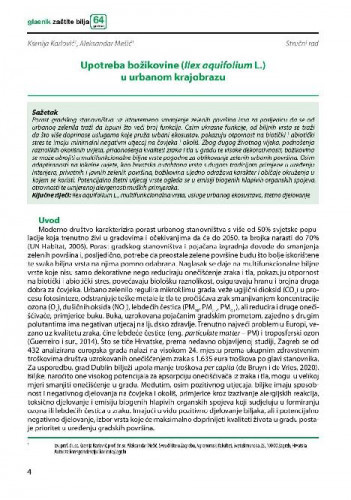Porast gradskog stanovništva uz istovremeno smanjenje zelenih površina ima za posljedicu da se od urbanog zelenila traži da ispuni što veći broj funkcija. Osim ukrasne funkcije, od biljnih vrsta se traži da što više doprinose uslugama koje pruža urbani ekosustav, pokazuju otpornost na biotički i abiotički stres te imaju minimalni negativni utjecaj na čovjeka i okoliš. Zbog dugog životnog vijeka, podnošenja raznolikih okolišnih uvjeta, pridonošenja kvaliteti zraka i tla u gradu te visoke dekorativnosti, božikovina se može ubrojiti u multifunkcionalne biljne vrste pogodne za oblikovanje zelenih urbanih površina. Osim adaptiranosti na lokalne uvjete, kao hrvatska autohtona vrsta s dugom tradicijom primjene u uređenju interijera, privatnih i javnih zelenih površina, božikovina ujedno odražava karakter i običaje okruženja u kojem se koristi. Potencijalno štetni utjecaj vrste ogleda se u emisiji biogenih hlapivih organskih spojeva, otrovnosti te umjerenoj alergenosti muških primjeraka.; The increase of urban population coupled with the reduced green spaces results in a necessity for urban greenery to fulfill as many functions as possible. Apart from ornamental function, plant species should enhance urban ecosystem services, be resistant to biotic and abiotic stress, and exert minimal negative impact on man and the environment. Due to its long lifespan, the tolerance of various environmental conditions, the contribution to air and soil quality in the city and ornamental properties, holly can be considered multifunctional plant species suitable for urban green areas. In addition to being adapted to local conditions, as a Croatian native species with a long history of use in design of interiors, private and public green spaces, holly also reflects the character and the tradition of the surroundings in which it is being used. The potentially harmful influence of the species is reflected in the emission of biogenic volatile organic compounds, toxicity and moderate allergenicity of male specimens.
Sažetak

 Glasnik zaštite bilja : 43,6(2020) / glavni urednik Katarina Lučić.
Glasnik zaštite bilja : 43,6(2020) / glavni urednik Katarina Lučić.